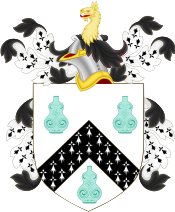Simon Willard (Massachusetts colonist)
Simon Willard | |
|---|---|
Charlestown, Massachusetts | |
| Occupation(s) | 1636–1654: Concord Representative, Massachusetts General Court 1640s–1650s: Advistor to the Nashaway Company, founder of Lancaster, Massachusetts 1654–1676: Assistant and Councillor 1676: Major in King Philip's War |
| Spouse(s) | Marye Sharpe (1614–1634) (married October 13, 1628) Elizabeth Dunster (1635–1651) (married 1651) Mary Dunster (1630–1715) (married 1652) |
Simon Willard (1605–1676) was an early Massachusetts fur trader, colonial militia leader, legislator, and judge.
Early life

Willard was born in
Kent, England and baptized on April 7, 1605. He emigrated to Cambridge, Massachusetts in 1634 with his first wife Mary Sharpe and their daughters Mary and Elizabeth. He was a founder of Concord, Massachusetts and served it as clerk from 1635 to 1653 and helped negotiate its purchase from the Native American owners. Willard represented Concord in the Massachusetts General Court from 1636 to 1654, and was assistant and councilor from 1654 to 1676.[1][2][3][4][5]
Work with settlement and Native Americans
Willard served as an advisor to the Nashaway Company which founded
The Willard Elementary School in Concord, Massachusetts, is named after Willard. The Liberty ship 0743 Simon Willard was also named after him.
Founding of Old Saybrook, Connecticut
Simon Willard has been chronicled as one of the founders of
Old Saybrook, Connecticut. Willard, then a Sergeant, and Lieutenant Edward Gibbons, were sent by John Winthrop (1606–1676) — son of John Winthrop (1587–1649), Governor of the Massachusetts Bay Colony — to occupy the mouth of what is now the Connecticut River (Long Island Sound) with 20 carpenters and workmen. On November 24, 1635, the group landed on the west bank at the mouth of the Connecticut River. They located the Dutch coat of arms and replaced it with a shield that had a grinning face painted on it. The group established a small fort with a cannon. When the Dutch returned to the mouth of the river, they spotted the English fort and withdrew. The fort was one of the first military establishments in the Connecticut Colony.[10]
See also
Bibliography
Notes
- ^ a b Wilson & Fiske, 1889.
- ^ Bodge, 1891.
- ^ Bodge, 1896.
- ^ Bartlett, 1907.
- ^ Pope, 1915.
- ^ a b Grant-Costa & Glaza.
- ^ a b Brooks, 2018.
- ^ Guttridge, 1921.
- ^ Society, 1906.
- ^ Wick.
References linked to notes
- )
- .
- .
- Brooks, Lisa Tanya (2018). "Interlude: Nashaway: Nipmuc Country, 1643–1674". Our Beloved Kin – A New History of King Philip's War. .
- Grant-Costa, Paul Joseph; Glaza, Tobias E., eds. (n.d.). "Willard Simon, 1605–1676". Native Northeast Portal. Transcribed from the Yale Indian Papers Series, Yale Divinity School.
- "Willard Simon, 1605–1676". Yale Divinity School. The Yale Indian Papers Project: Box 434. Archived from the original on June 1, 2019.
- Gutteridge, William Henry (1921). A Brief History of the Town of Maynard, Massachusetts. Boston: .
- Pope, Charles Henry, ed. (1915). "First Generation". Willard Genealogy – Sequel to Willard Memoir. Boston: The Willard Family Association. pp. 4–14. .
- Wick, Steven B. "1635–Saybrook". Society of Colonial Wars in the State of Connecticut. Retrieved February 5, 2010.
- .
General references
- Willard, Joseph (1858). Willard Memoir, or Life and Times of Major Simon Willard: With Notices of Three Generations of His Descendants, and Two Collateral Branches in the United States; Also Some Account of the Family in Europe, From an Early Day. Boston: Phillips, Sampson, and Company. pp. 125, 132, 142–150, 157, 183–184, 212. ).
Further reading
- "Copy of a Letter From Major Simon Willard to the Commissioners of the United Colonies". A Collection of Original Papers Relative to the History of the Colony of Massachusetts-Bay. Boston: Thomas and John Fleet. 1769. pp. 263–164. .
- "Copy of a Letter From Major Simon Willard to the Commissioners of the Colonies". The Hutchinson Papers. Vol. 1. .
